Effect of Superhydrophobic Nano-SiO2 on the Hydraulic Conductivity of Expansive Soil and Analysis of Its Mechanism
Abstract
:1. Introduction
2. Materials and Methods
2.1. Materials
2.2. Sample Preparation
2.3. Test Methods
2.3.1. Hydraulic-Conductivity Test
2.3.2. Nuclear Magnetic Resonance (NMR)
2.3.3. Fourier Transform Mid-Infrared (FTIR) Spectroscopy
2.3.4. Contact Angle Measurement
2.3.5. Thermogravimetric Analysis
3. Hydraulic Conductivity of Soil Samples with Various SiO2 Contents
4. Test Results and Mechanism Analysis
4.1. Effect of Nano-SiO2 on the PSD of Soil Samples
4.2. Effect of Nano-SiO2 on the FTIR Spectra of Soil Samples
4.3. Effect of Nano-SiO2 on the Hydrophobicity of Soil Samples
4.4. Effect of Nano-SiO2 on the TGA Curves of Soil Samples
4.5. Mechanism of Superhydrophobic Nano-SiO2 on the PSD of Soil Samples
5. Correlation between Hydraulic Conductivity and PSD of Modified Soil Samples
6. Conclusions
- (1)
- The hydraulic conductivity of soil samples decreased with increasing superhydrophobic nano-SiO2 content.
- (2)
- The PSD of expansive soil was changed by adding superhydrophobic nano-SiO2. After the hydraulic-conductivity test, the pore radius of micropore, medium pore, and macropore of modified soil was smaller than that of unmodified soil. This finding indicated that the pore volume of soil samples decreased with increasing nano-SiO2 content in the range of 0.0–1.0%.
- (3)
- FTIR results indicated that the silanol on the nano-SiO2 surface reacted with the silanol on the surface of quartz to form new siloxane (=Si–O–Si=) after adding nano-SiO2, causing the nano-SiO2 to adhere onto the surface of the soil particles and thus reducing the hydrophilicity of expansive soil. After adding superhydrophobic nano-SiO2, the contact angle of samples increased from 15° to 67°. And TGA results revealed that the content of interlayer water and adsorbed water in montmorillonite decreased after adding superhydrophobic nano-SiO2.
- (4)
- Based on the above test results, it can be stated that superhydrophobic nano-SiO2 could reduce the hydraulic conductivity by changing the PSD of expansive soil. It had an excellent linear relationship with the hydraulic conductivity and permeable pore volume of samples containing different nano-SiO2 contents.
Author Contributions
Funding
Data Availability Statement
Acknowledgments
Conflicts of Interest
List of Symbols
| shape factor | |
| () | hydraulic conductivity |
| () | permeability |
| () | radius of pores |
| () | radius of curvature |
| () | radius of curvature |
| S () | surface area |
| () | relaxation time |
| () | bulk fluid relaxation time |
| () | diffusion relaxation time |
| () | geometric mean value of spectrum |
| () | surface relaxation time |
| () | pore volume |
| () | relaxation coefficient |
| () | density of water |
| (%) | porosity |
| () | hydraulic pressure |
| () | capillary pressure |
| () | surface tension of water |
References
- Wang, M.; Kong, L.; Zhao, C.; Zang, M. Dynamic characteristics of lime-treated expansive soil under cyclic loading. J. Rock Mech. Geotech. Eng. 2012, 4, 352–359. [Google Scholar] [CrossRef]
- Kong, L.-W.; Zeng, Z.-X.; Bai, W.; Wang, M. Engineering geological properties of weathered swelling mudstones and their effects on the landslides occurrence in the Yanji section of the Jilin-Hunchun high-speed railway. Bull. Eng. Geol. Environ. 2018, 77, 1491–1503. [Google Scholar] [CrossRef]
- Cheng, Y.; Xu, Y.; Wang, L.; Wang, L. Stability of expansive soil slopes reinforced with anchor cables based on rotational-translational mechanisms. Comput. Geotech. 2022, 146, 104747. [Google Scholar] [CrossRef]
- Khan, M.S.; Hossain, S.; Ahmed, A.; Faysal, M. Investigation of a shallow slope failure on expansive clay in Texas. Eng. Geol. 2017, 219, 118–129. [Google Scholar] [CrossRef]
- Houston, S.L.; Bharadwaj, A.; Welfert, B.; Houston, W.N.; Walsh, K.D. Unsaturated Soil Mechanics Principles to Remove and Replace Mitigation for Expansive Clays. J. Geotech. Geoenviron. Eng. 2016, 142, 04015102. [Google Scholar] [CrossRef]
- Kananizadeh, N.; Ebadi, T.; Khoshniat, S.A.; Mousavirizi, S.E. The Positive Effects of Nanoclay on the Hydraulic Conductivity of Compacted Kahrizak Clay Permeated With Landfill Leachate. Clean Soil Air Water 2011, 39, 605–611. [Google Scholar] [CrossRef]
- Ng, C.W.W.; Coo, J.L. Hydraulic conductivity of clay mixed with nanomaterials. Can. Geotech. J. 2015, 52, 808–811. [Google Scholar] [CrossRef]
- Taha, O.M.E.; Taha, M.R. Soil-water characteristic curves and hydraulic conductivity of nanomaterial-soil-bentonite mixtures. Arab. J. Geosci. 2015, 9, 12. [Google Scholar] [CrossRef]
- Gallagher, P.; Lin, Y. Column Testing to Determine Colloidal Silica Transport Mechanisms. In Innovations in Grouting and Soil Improvement, Proceedings of the Geo-Frontiers 2005, Austin, TX, USA, 24–26 January 2005; ASCE: Reston, VA, USA, 2005; pp. 1–10. [Google Scholar] [CrossRef]
- Benzel, W.M.; Graf, D.L. Studies of smectite membrane behavior: Importance of layer thickness and fabric in experiments at 20 °C. Geochim. Cosmochim. Acta 1984, 48, 1769–1778. [Google Scholar] [CrossRef]
- Neithalath, N.; Sumanasooriya, M.S.; Deo, O. Characterizing pore volume, sizes, and connectivity in pervious concretes for permeability prediction. Mater. Charact. 2010, 61, 802–813. [Google Scholar] [CrossRef]
- An, R.; Kong, L.; Li, C. Pore Distribution Characteristics of Thawed Residual Soils in Artificial Frozen-Wall Using NMRI and MIP Measurements. Appl. Sci. 2020, 10, 544. [Google Scholar] [CrossRef] [Green Version]
- Sedighi, M.; Thomas, H.R. Micro porosity evolution in compacted swelling clays—A chemical approach. Appl. Clay Sci. 2014, 101, 608–618. [Google Scholar] [CrossRef]
- Kong, L.; Sayem, H.M.; Tian, H. Influence of drying–wetting cycles on soil-water characteristic curve of undisturbed granite residual soils and microstructure mechanism by nuclear magnetic resonance (NMR) spin-spin relaxation time (T2) relaxometry. Can. Geotech. J. 2018, 55, 208–216. [Google Scholar] [CrossRef] [Green Version]
- Luo, X.; Kong, L.-W.; Bai, W.; Jian, T. Effect of Superhydrophobic Nano-SiO2 on the Geotechnical Characteristics of Expansive Soil. J. Test. Eval. 2022, 50, 2932–2947. [Google Scholar] [CrossRef]
- Goydaragh, M.G.; Taghizadeh-Mehrjardi, R.; Jafarzadeh, A.A.; Triantafilis, J.; Lado, M. Using environmental variables and Fourier Transform Infrared Spectroscopy to predict soil organic carbon. CATENA 2021, 202, 105280. [Google Scholar] [CrossRef]
- Yuan, Z.; Teodoriu, C.; Schubert, J. Low cycle cement fatigue experimental study and the effect on HPHT well integrity. J. Pet. Sci. Eng. 2013, 105, 84–90. [Google Scholar] [CrossRef]
- ASTM D698-12e2; Standard Test Methods for Laboratory Compaction Characteristics of Soil Using Standard Effort (12 400 ft-lbf/ft3 (600 kN-m/m3)). ASTM International: West Conshohocken, PA, USA, 2012. [CrossRef]
- Wang, Y.; Yang, Q.; Liu, C.; Liu, H.; Lin, C.; Xiao, P.; Gong, L. Research progress of nonmetallic superhydrophobic nanocoating technology. Mater. Rev. 2020, 34, 66–71. [Google Scholar]
- Xi, Y.; Li, J.; Tao, Q.; Guo, B.; Liu, G. Experimental and numerical investigations of accumulated plastic deformation in cement sheath during multistage fracturing in shale gas wells. J. Pet. Sci. Eng. 2020, 187, 106790. [Google Scholar] [CrossRef]
- Xiao, L.; Mao, Z.-Q.; Zou, C.-C.; Jin, Y.; Zhu, J.-C. A new methodology of constructing pseudo capillary pressure (Pc) curves from nuclear magnetic resonance (NMR) logs. J. Pet. Sci. Eng. 2016, 147, 154–167. [Google Scholar] [CrossRef]
- Leij, F.J.; Ghezzehei, T.A.; Or, D. Analytical Models for Soil Pore-Size Distribution after Tillage. Soil Sci. Soc. Am. J. 2002, 66, 1104–1114. [Google Scholar] [CrossRef] [Green Version]
- Stingaciu, L.R.; Weihermüller, L.; Haber-Pohlmeier, S.; Stapf, S.; Vereecken, H.; Pohlmeier, A. Determination of pore size distribution and hydraulic properties using nuclear magnetic resonance relaxometry: A comparative study of laboratory methods. Water Resour. Res. 2010, 46, W11510. [Google Scholar] [CrossRef] [Green Version]
- Dunn, K.J.; Bergman, D.J.; Latorraca, G.A. (Eds.) Chapter 5 NMR logging applications. In Handbook of Geophysical Exploration: Seismic Exploration; Pergamon: Oxford, UK, 2002; Volume 32, pp. 129–164. [Google Scholar]
- Tian, H.; Wei, C.; Wei, H.; Yan, R.; Chen, P. An NMR-Based Analysis of Soil–Water Characteristics. Appl. Magn. Reson. 2014, 45, 49–61. [Google Scholar] [CrossRef]
- Gao, Q.-F.; Zhao, D.; Zeng, L.; Dong, H. A Pore Size Distribution-based Microscopic Model for Evaluating the Permeability of Clay. KSCE J. Civ. Eng. 2019, 23, 5002–5011. [Google Scholar] [CrossRef]
- Daigle, H.; Dugan, B. Extending NMR data for permeability estimation in fine-grained sediments. Mar. Pet. Geol. 2009, 26, 1419–1427. [Google Scholar] [CrossRef]
- Xiong, H.; Yuan, K.; Wen, M.; Yu, A.; Xu, J. Influence of pore structure on the moisture transport property of external thermal insulation composite system as studied by NMR. Constr. Build. Mater. 2019, 228, 116815. [Google Scholar] [CrossRef]
- Ghebleh Goydaragh, M.; Taghizadeh-Mehrjardi, R.; Golchin, A.; Asghar Jafarzadeh, A.; Lado, M. Predicting weathering indices in soils using FTIR spectra and random forest models. CATENA 2021, 204, 105437. [Google Scholar] [CrossRef]
- Madejová, J. FTIR techniques in clay mineral studies. Vib. Spectrosc. 2003, 31, 1–10. [Google Scholar] [CrossRef]
- Müller, C.M.; Pejcic, B.; Esteban, L.; Piane, C.D.; Raven, M.; Mizaikoff, B. Infrared Attenuated Total Reflectance Spectroscopy: An Innovative Strategy for Analyzing Mineral Components in Energy Relevant Systems. Sci. Rep. 2014, 4, 6764. [Google Scholar] [CrossRef] [Green Version]
- Barthlott, W.; Neinhuis, C. Purity of the sacred lotus, or escape from contamination in biological surfaces. Planta 1997, 202, 1–8. [Google Scholar] [CrossRef]
- Tan, R.; Kong, L. Engineering Properties of Special Rock and Soil; Science Press: Beijing, China, 2006. [Google Scholar]


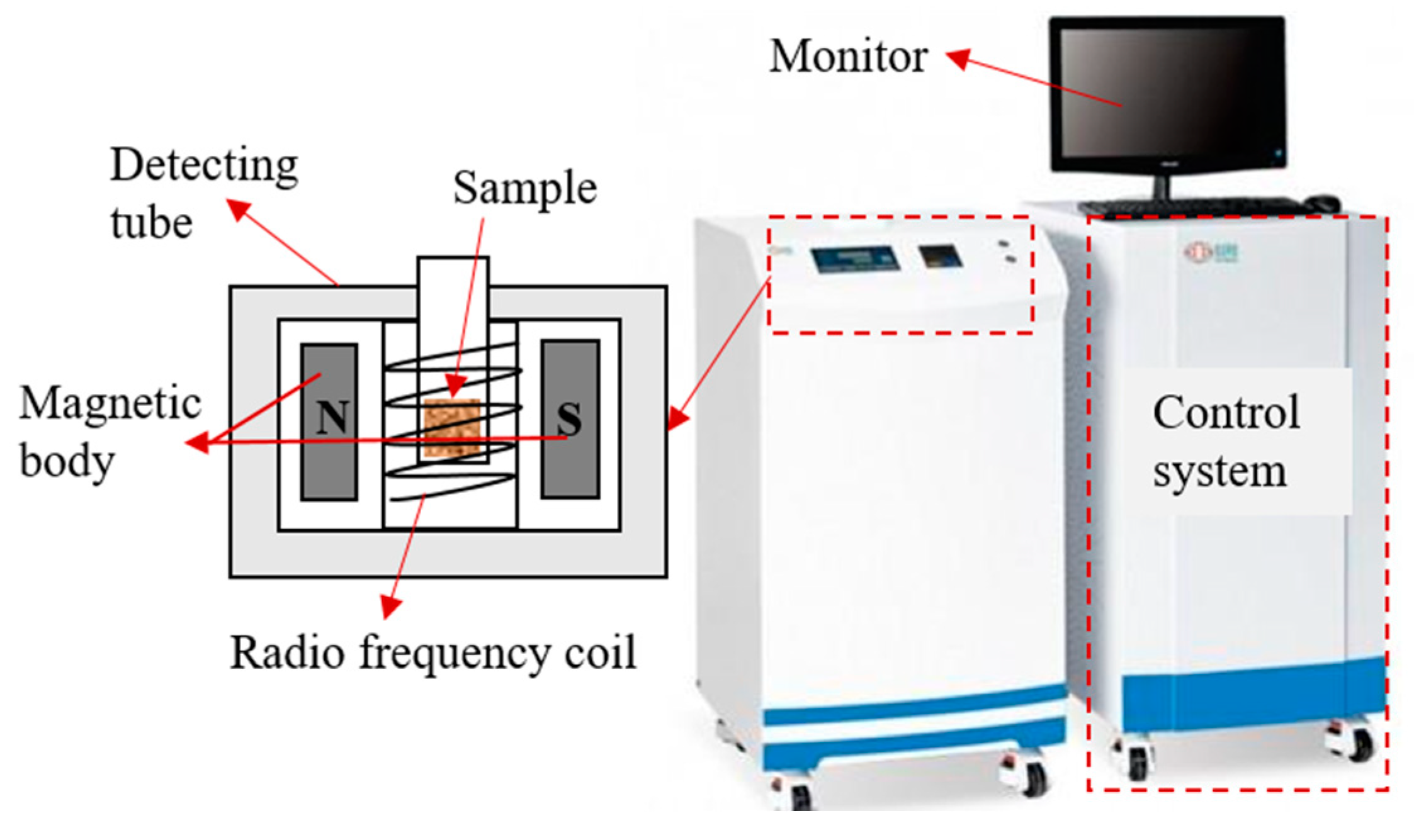
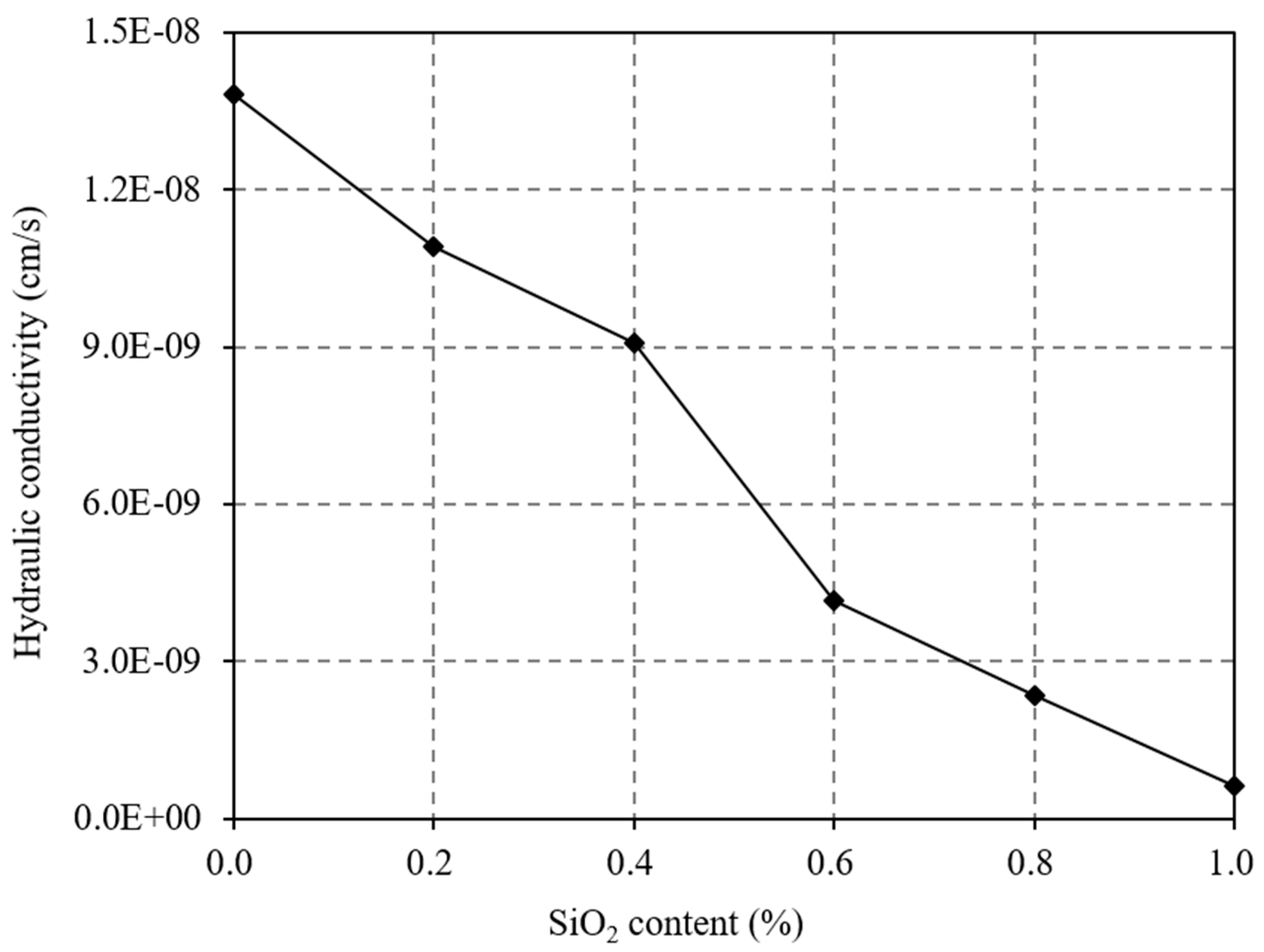
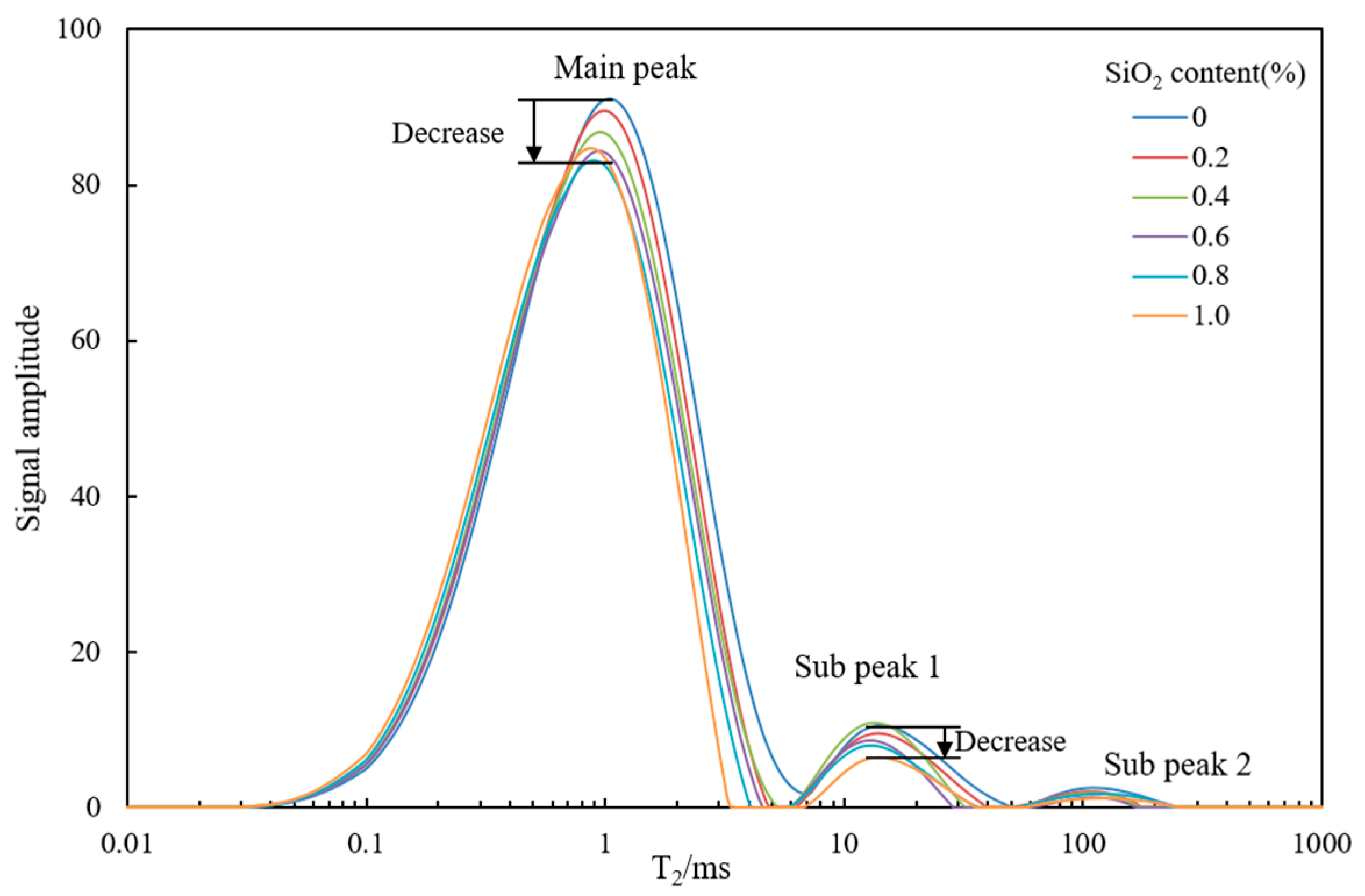
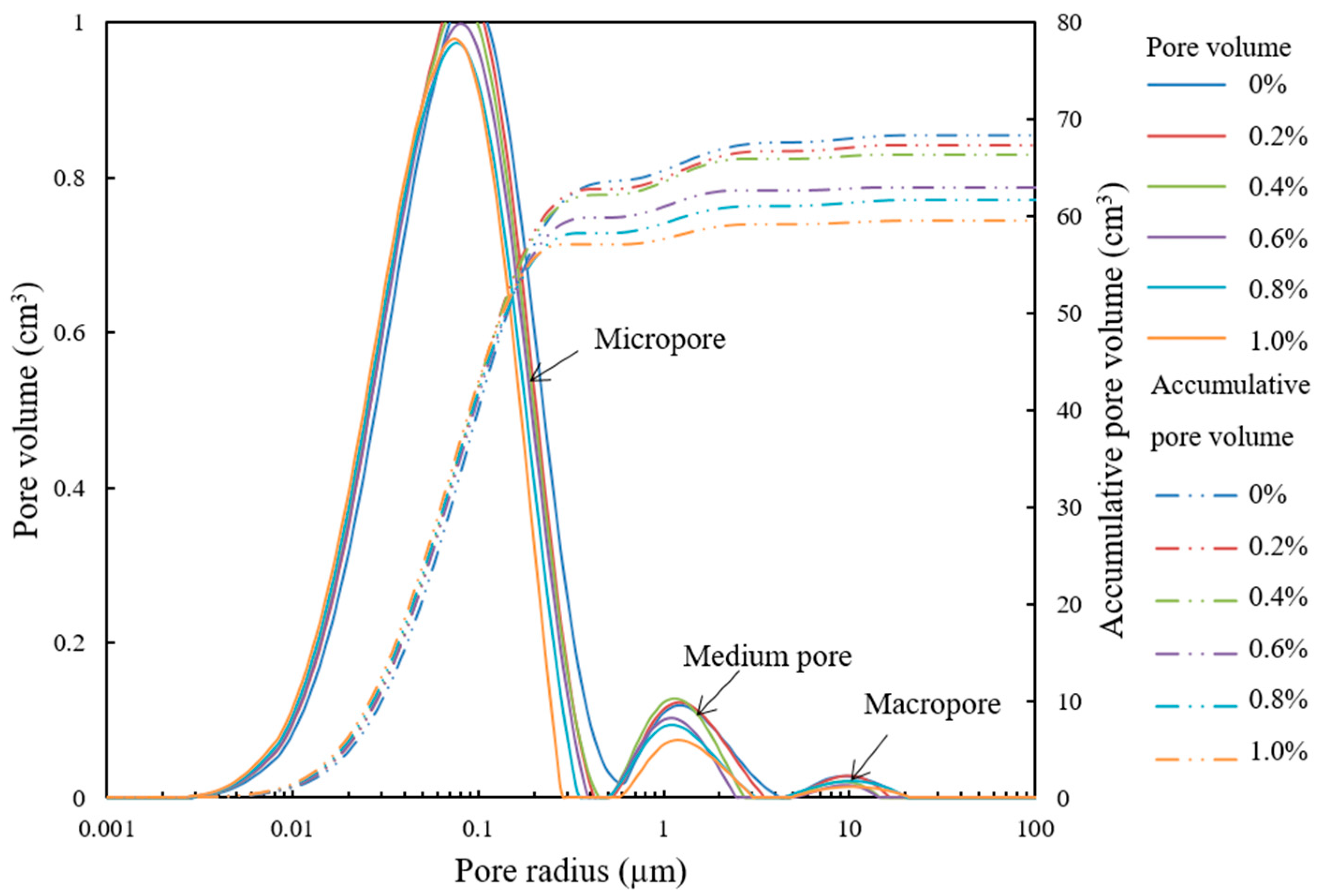
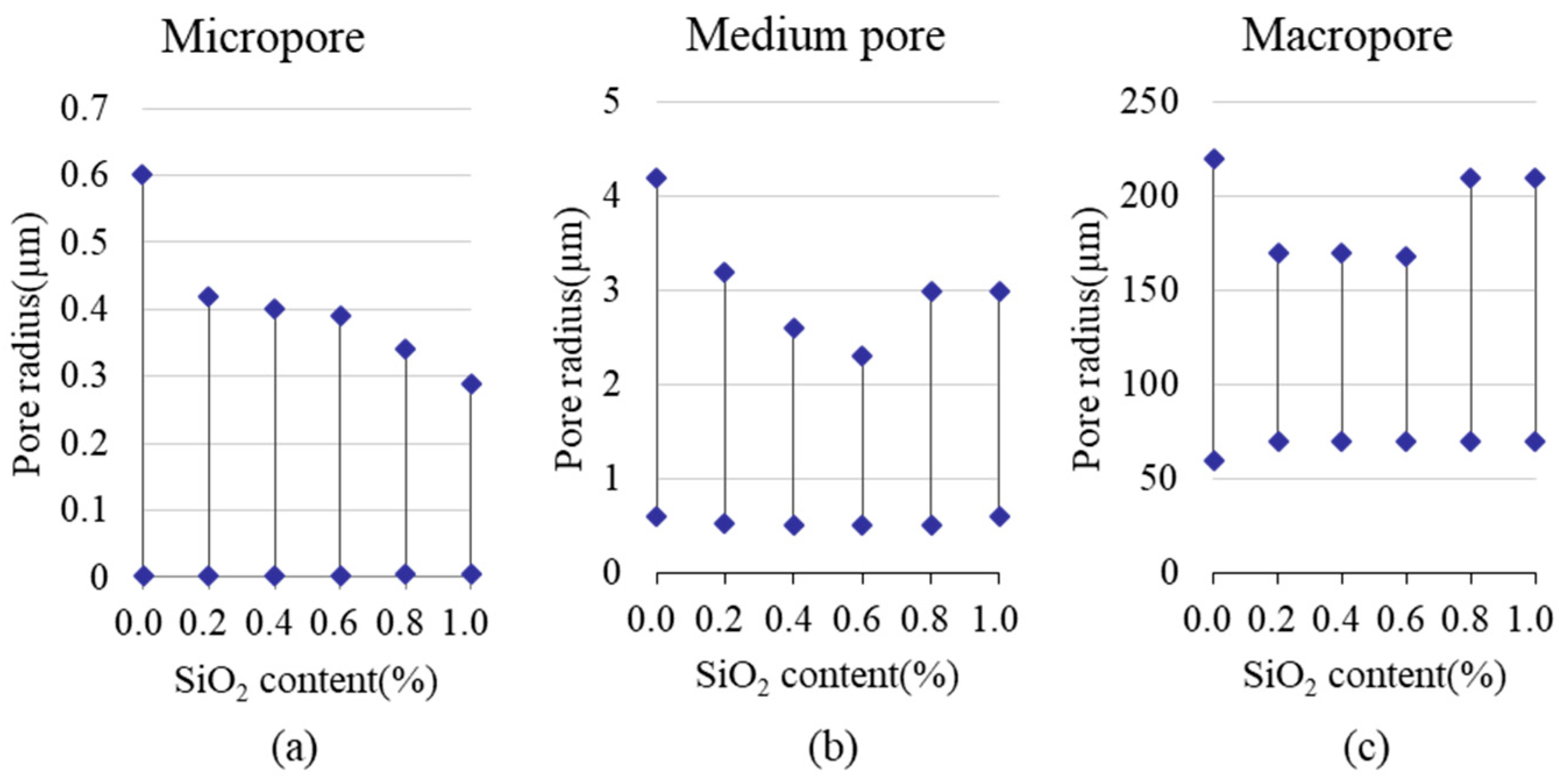
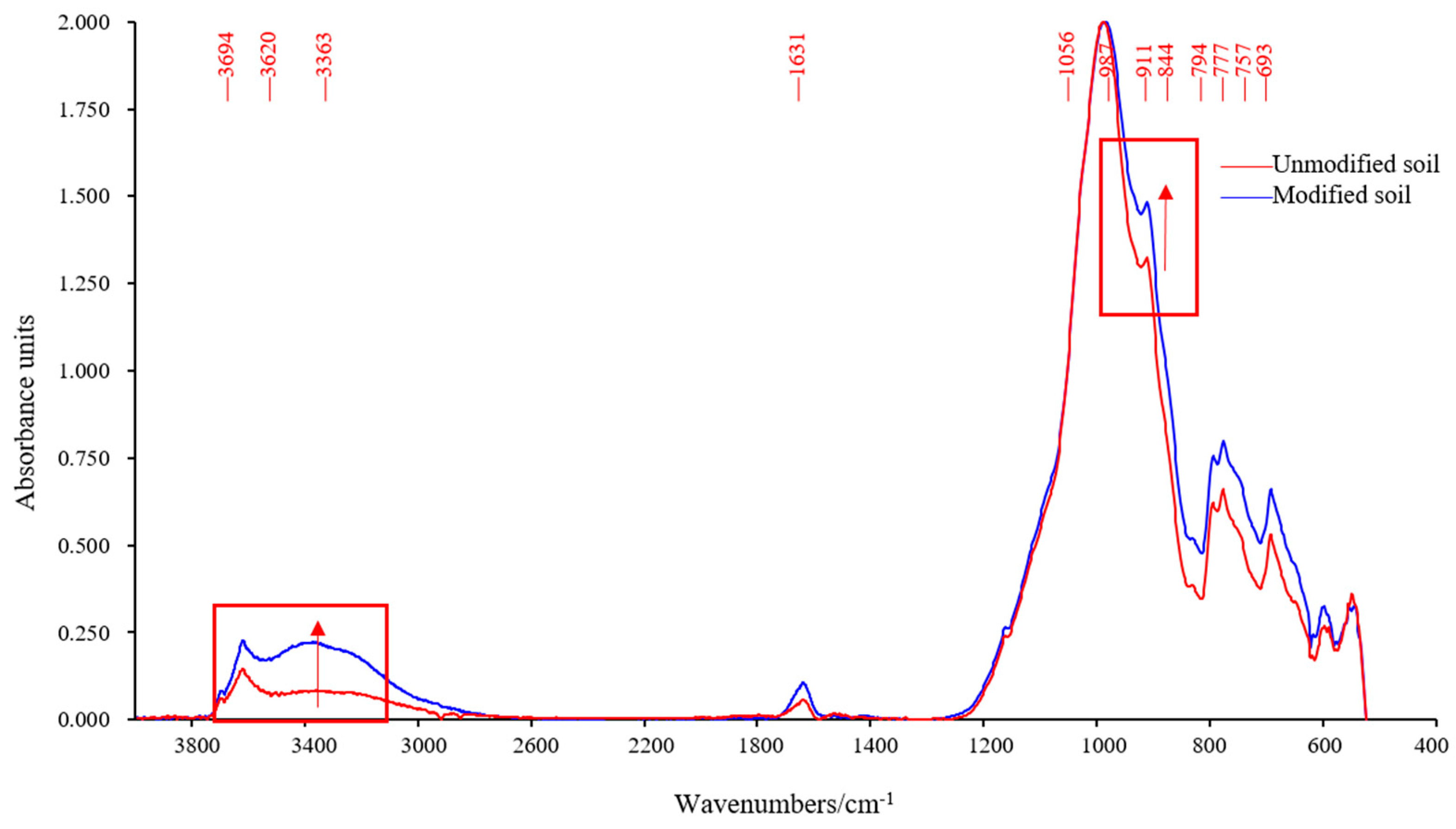
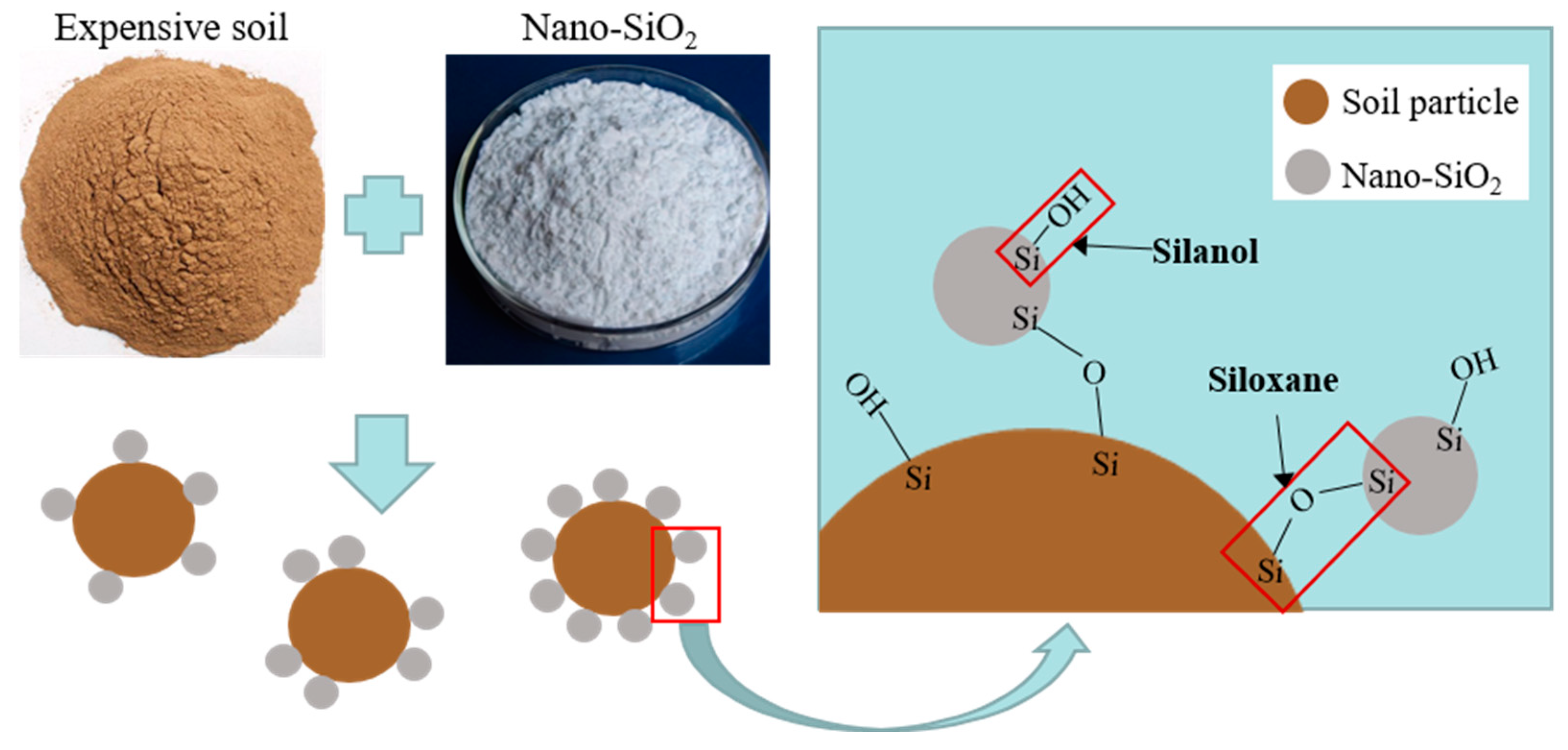
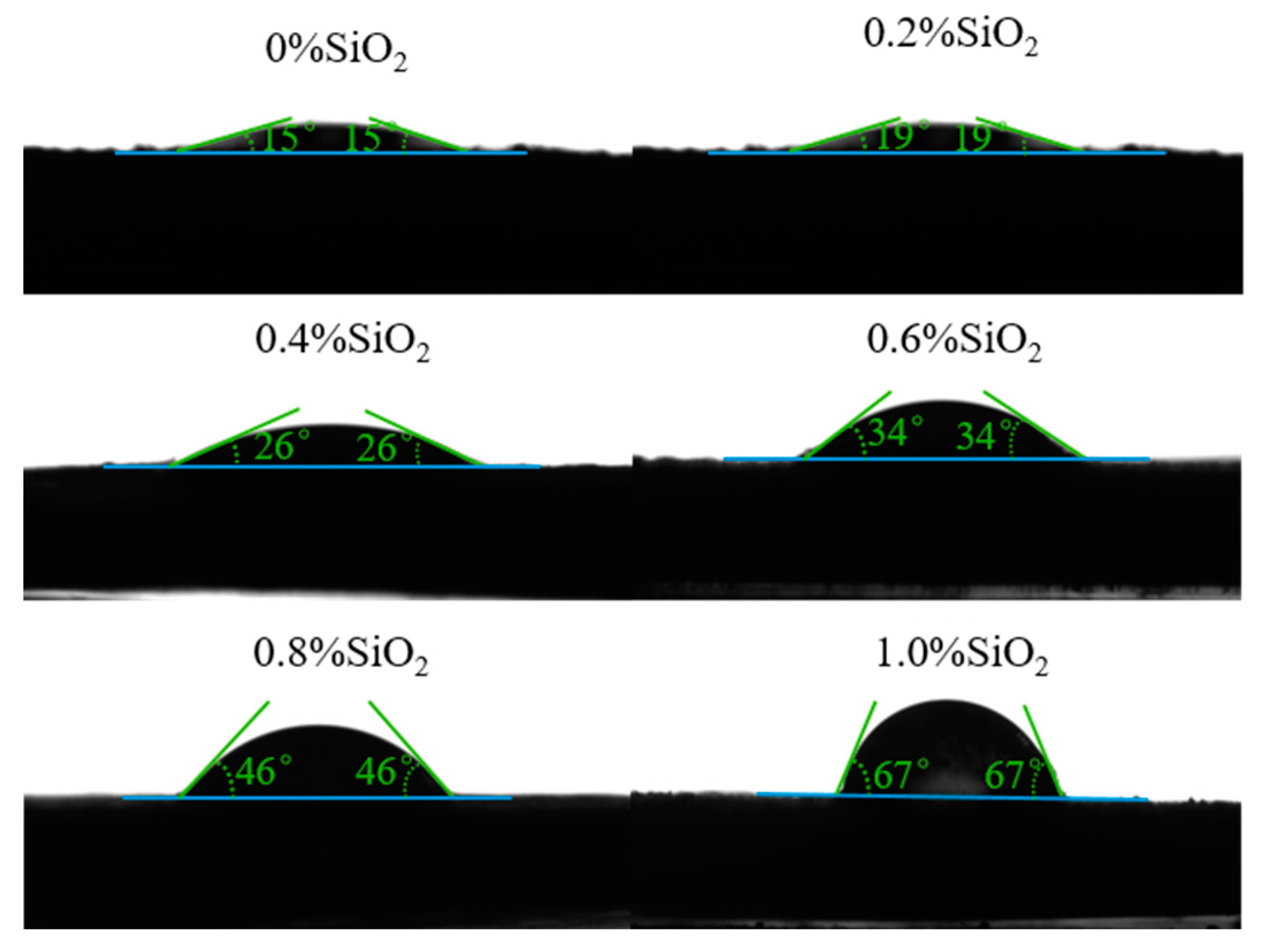
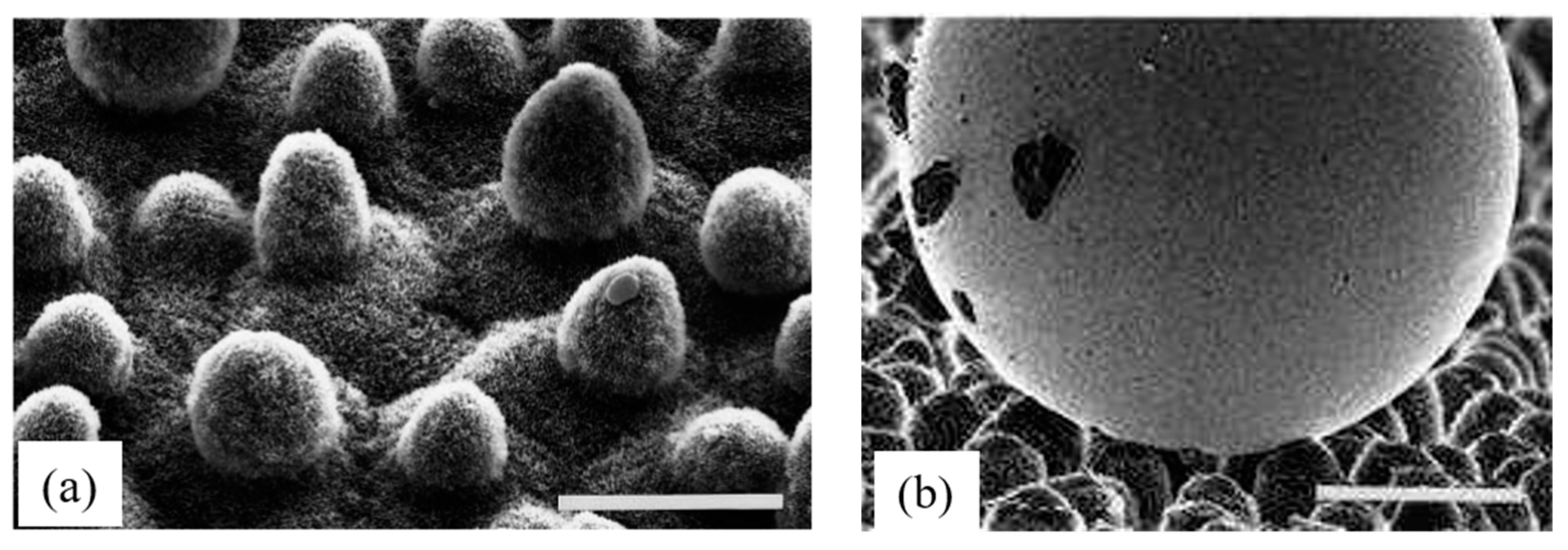
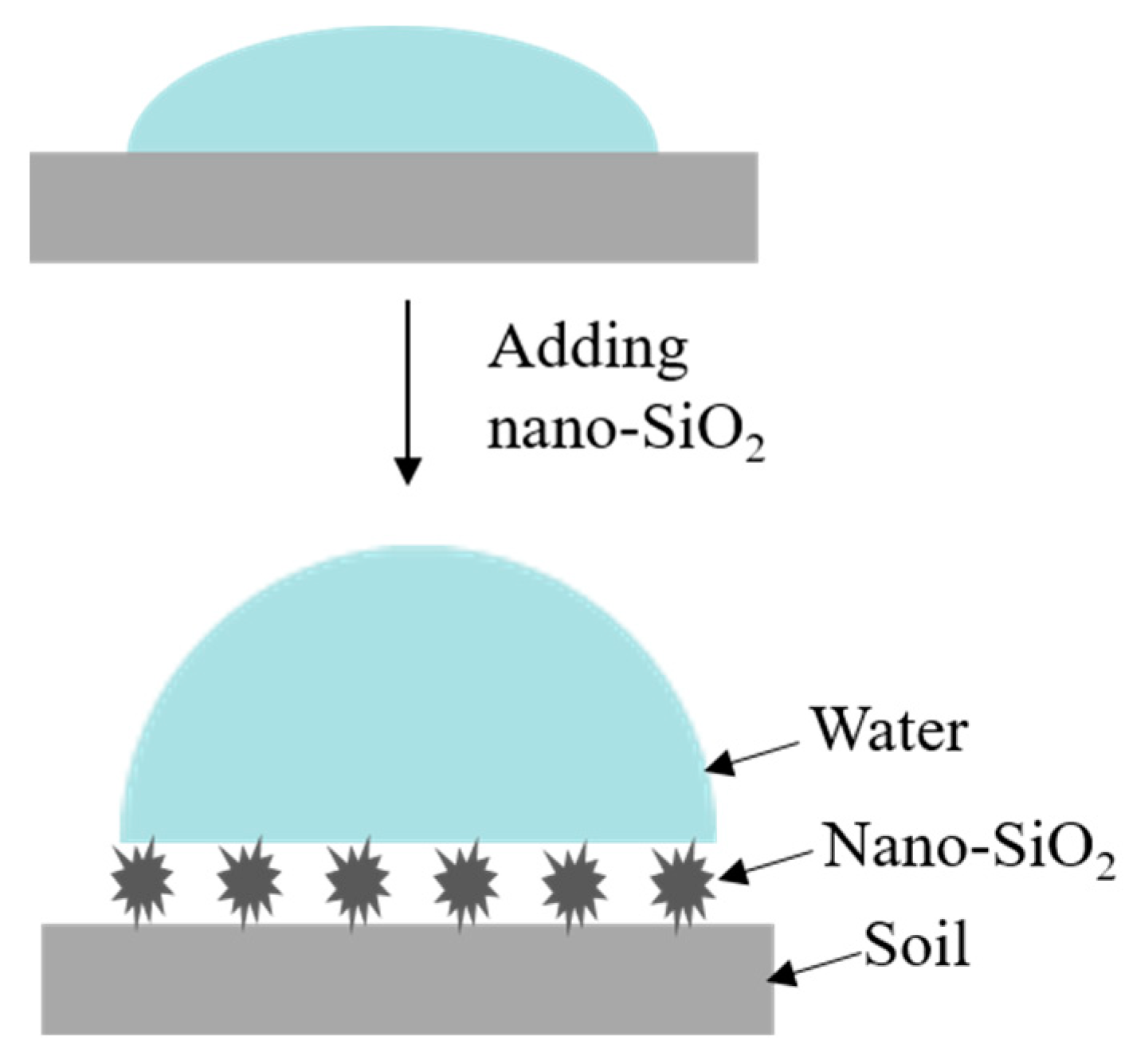
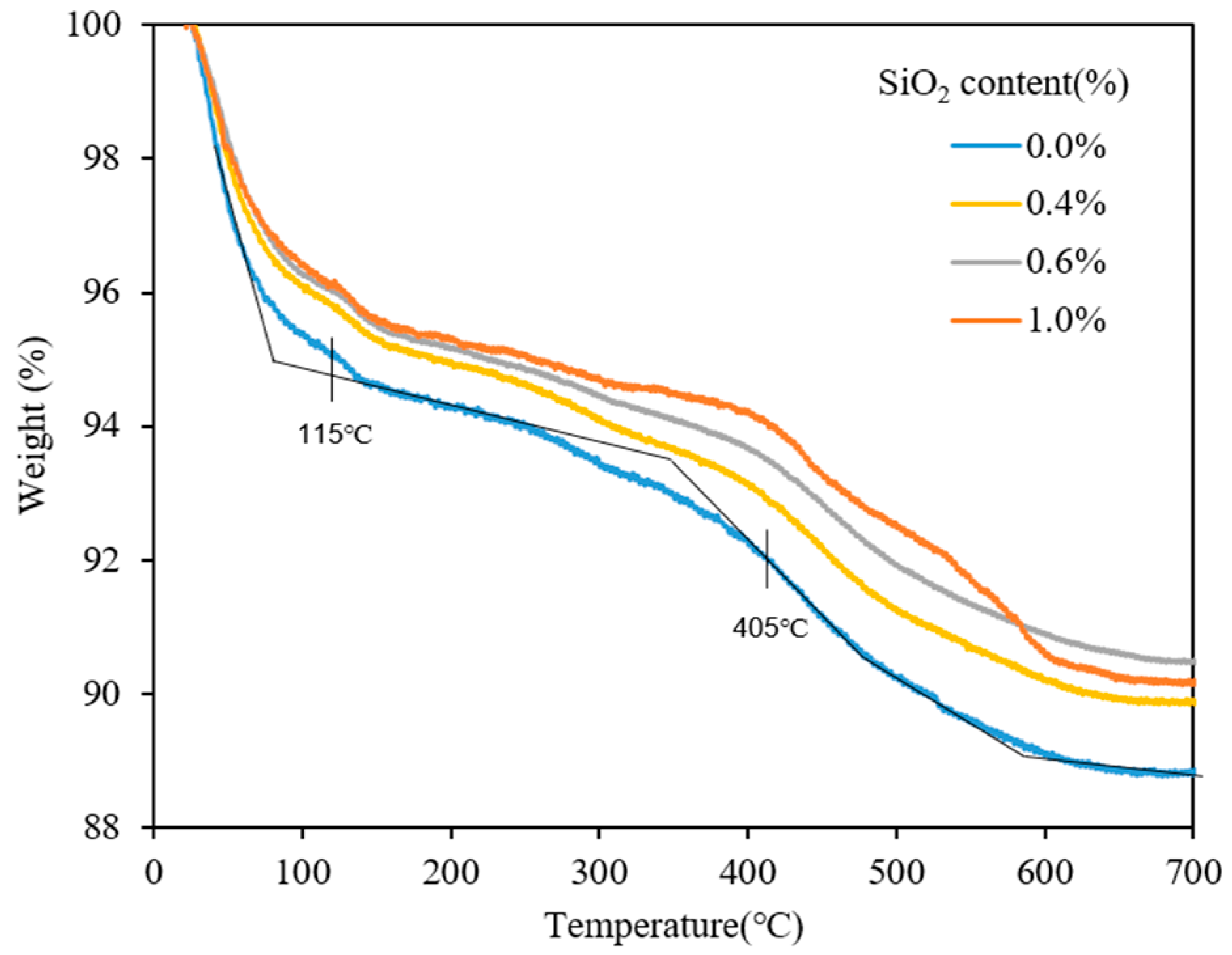

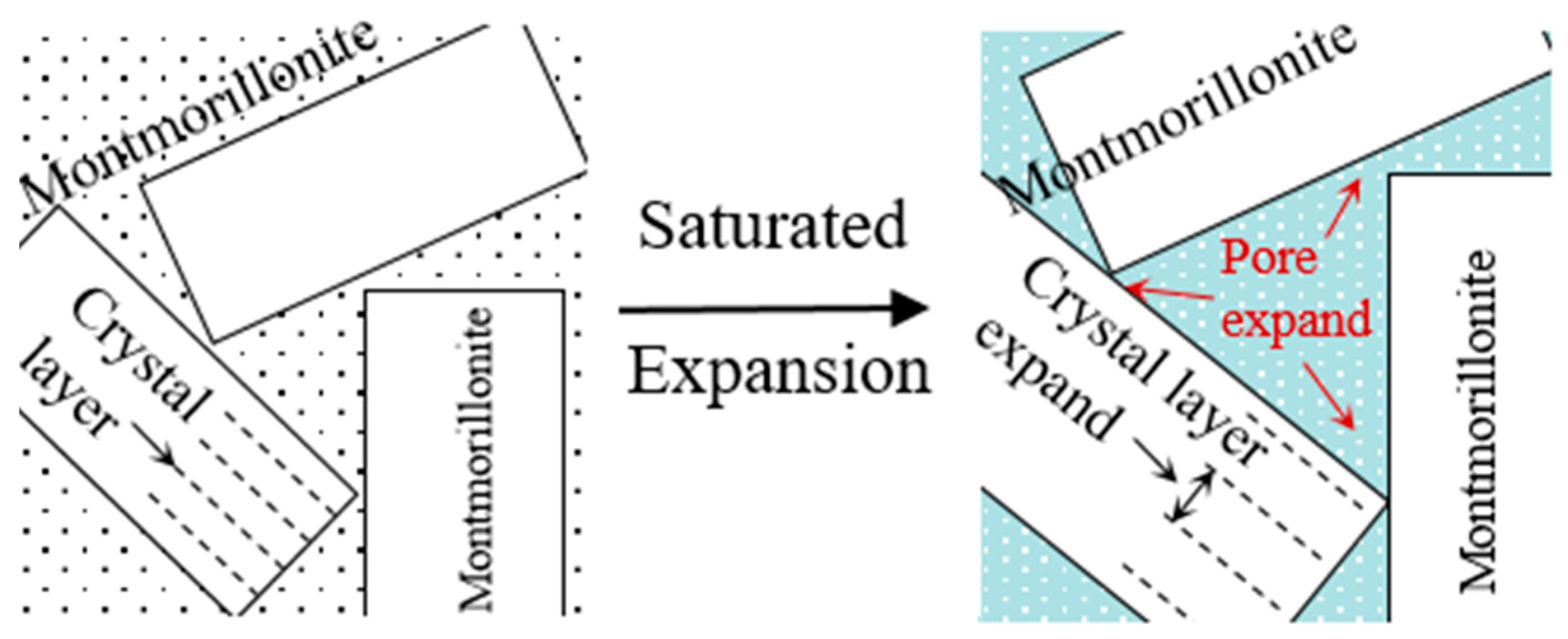

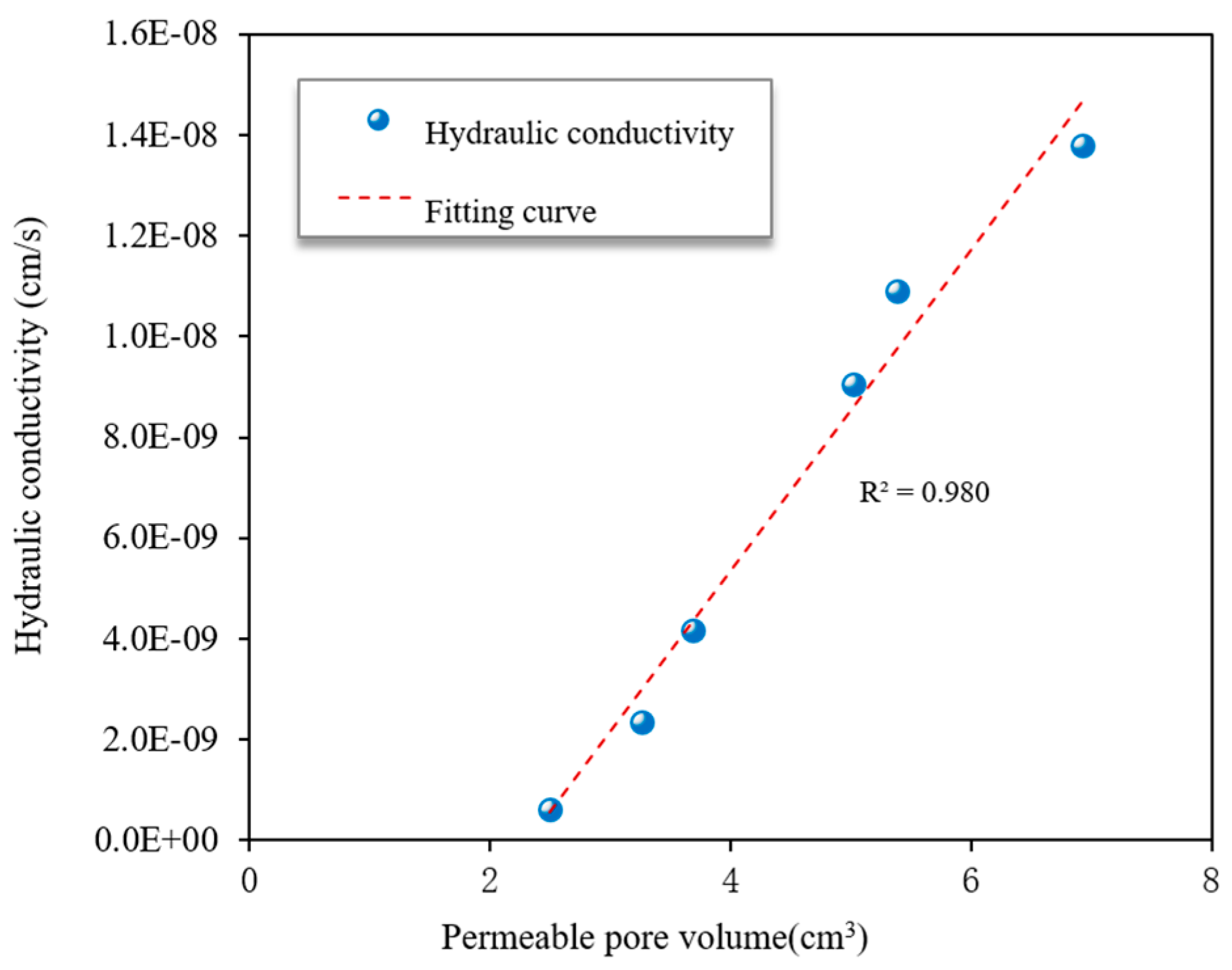
| Properties | Value |
|---|---|
| Specific gravity | 2.64 |
| Sand (2 mm ≥ d > 0.075 mm) (%) | 2.0 |
| Silt (0.075 mm ≥ d > 0.005 mm) (%) | 43.0 |
| Clay (d ≤ 0.005 mm) (%) | 55.0 |
| Free swelling ratio (%) | 52.0 |
| Liquid limit (%) | 48.3 |
| Plastic limit (%) | 22.8 |
| Optimum water content (%) | 18.0 |
| Maximum dry density (g/cm3) | 1.78 |
| Properties | Value |
|---|---|
| Nano type | Hydrophobic nano-SiO2 |
| SiO2 purity (%) | 99 |
| Average particle size (nm) | 20 |
| Specific surface area (m2/g) | 180 |
| PH | 5.5–6.5 |
| Colour | White |
| Contact angle (°) | 151.9 |
| SiO2 Content (%) | Total Pore Volume (cm3) | ||||
|---|---|---|---|---|---|
| r < 0.01 | 0.01 ≤ r < 0.1 | 0.1 ≤ r < 1 | 1 ≤ r | ||
| Volume (cm3) | |||||
| 0 | 68.5 | 0.97 | 39.60 | 25.17 | 2.73 |
| 0.2 | 67.4 | 1.11 | 41.75 | 22.27 | 3.38 |
| 0.4 | 66.3 | 1.15 | 41.72 | 20.64 | 2.79 |
| 0.6 | 63.0 | 1.13 | 40.70 | 19.20 | 1.97 |
| 0.8 | 61.7 | 1.25 | 41.10 | 16.74 | 2.47 |
| 1.0 | 59.6 | 1.38 | 41.98 | 14.33 | 1.91 |
Disclaimer/Publisher’s Note: The statements, opinions and data contained in all publications are solely those of the individual author(s) and contributor(s) and not of MDPI and/or the editor(s). MDPI and/or the editor(s) disclaim responsibility for any injury to people or property resulting from any ideas, methods, instructions or products referred to in the content. |
© 2023 by the authors. Licensee MDPI, Basel, Switzerland. This article is an open access article distributed under the terms and conditions of the Creative Commons Attribution (CC BY) license (https://creativecommons.org/licenses/by/4.0/).
Share and Cite
Luo, X.; Kong, L.; Bai, W. Effect of Superhydrophobic Nano-SiO2 on the Hydraulic Conductivity of Expansive Soil and Analysis of Its Mechanism. Appl. Sci. 2023, 13, 8198. https://doi.org/10.3390/app13148198
Luo X, Kong L, Bai W. Effect of Superhydrophobic Nano-SiO2 on the Hydraulic Conductivity of Expansive Soil and Analysis of Its Mechanism. Applied Sciences. 2023; 13(14):8198. https://doi.org/10.3390/app13148198
Chicago/Turabian StyleLuo, Xiaoqian, Lingwei Kong, and Wei Bai. 2023. "Effect of Superhydrophobic Nano-SiO2 on the Hydraulic Conductivity of Expansive Soil and Analysis of Its Mechanism" Applied Sciences 13, no. 14: 8198. https://doi.org/10.3390/app13148198
APA StyleLuo, X., Kong, L., & Bai, W. (2023). Effect of Superhydrophobic Nano-SiO2 on the Hydraulic Conductivity of Expansive Soil and Analysis of Its Mechanism. Applied Sciences, 13(14), 8198. https://doi.org/10.3390/app13148198






